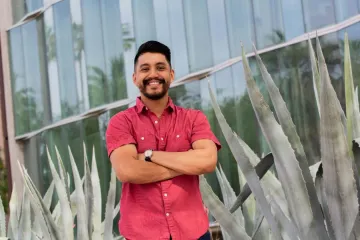Another Wavelength: Alex Samoy-Alvarado

Today in Another Wavelength, we chat with M.S. Student Alex Samoy-Alvarado currently advised by Dr. Elizabeth Hutchinson and mentored by Dr. Urs Utzinger.
Where are you from?
I am from Tucson, AZ.
What brought you to study optics?
After I finished my undergraduate degree, I worked as a math, science, and music educator for a number of years. Once I started working for the University of Arizona as an academic advisor, being around so many passionate and ambitious students inspired me to go back to school. Out of high school, my original plan was actually to study mechanical engineering. I was curious about making a career change back to something engineering related. I met with advisors from several graduate programs at UA, and eventually I ended up in Lindsay Loebig's office. Midway though our conversation, she stopped and said, "Want to see something cool?" I obviously said yes, and so she took me into the basement of the Meinel Building to show me the giant telescope mirrors being polished there. I was amazed, and I decided right then on the spot I wanted to be a part of the O.S. program. I started taking the background mathematics and physics courses part time, since I was working full time. Eventually, I developed a strong enough foundation in coursework to apply to the M.S. program as a full time student.

Who is your hero in science?
There are so many it's difficult to choose, but if I had to narrow it down it would be Jim Watson, Francis Crick, Rosalind Franklin, and Maurice Wilkins. Learning about DNA, transcription, and translation during my undergrad was the first time I truly understood the power of the scientific method.
Describe your research in 20 words or fewer.
I study the effects of traumatic brain injury on mice using in vivo multiphoton imaging methods.
Describe your research in 200 words or fewer.
I work in a lab with Dr. Elizabeth Hutchinson. We study the effects of traumatic brain injury (TBI) on translational animal models, with the intent of identifying biomarkers that will eventually become clinically relevant in the detection and treatment of TBI. We use a variety of imaging modalities to conduct our research including advanced MRI pulse sequences, photoacoustic imaging, and multiphoton microscopy.
I specifically work on a 2-photon microscope system belonging to Dr. Urs Utzinger. My work is integral to what we call "in-vivo validation." Other members of Dr. Hutchinson's research group perform brain injuries on animal models and image the effects non-invasively using novel MRI techniques. After the full battery of pulse sequences is complete, I image the specimen more invasively to confirm, or "validate" the accuracy of the MRI images. The goal is to identify biomarkers non-invasively (MRI), and then validate the accuracy of the biomarkers invasively (multiphoton) so that eventually, non-invasive imaging methods alone will be sufficient. The most fun part of my research is definitely using the Titanium Sapphire laser. It's powerful!
Name three neat facts about you.
- I was a music major for the first two years of my undergraduate schooling. My focus was percussion performance, and I ended up teaching drumline to high school students in Tucson for about 10 years as a side gig. I still play drums in a local rock band as a hobby. Pre-covid we played regularly at Club Congress, so hopefully we'll be able to do that again soon!
- My undergraduate degree was in Neuroscience and Cognitive Science. I think the brain is fascinating, and I'm thrilled to be involved in Dr. Hutchinson's brain imaging lab!
- I'm proud to be multiracial/multiethnic. The main ones are Filipino, Polynesian, and Hispanic. Once I finish my O.S. degree, I plan to get a traditional Polynesian tatau to commemorate the occasion as a coming of age.
